Zhuang Li
LazyReview A Dataset for Uncovering Lazy Thinking in NLP Peer Reviews
Apr 15, 2025Abstract:Peer review is a cornerstone of quality control in scientific publishing. With the increasing workload, the unintended use of `quick' heuristics, referred to as lazy thinking, has emerged as a recurring issue compromising review quality. Automated methods to detect such heuristics can help improve the peer-reviewing process. However, there is limited NLP research on this issue, and no real-world dataset exists to support the development of detection tools. This work introduces LazyReview, a dataset of peer-review sentences annotated with fine-grained lazy thinking categories. Our analysis reveals that Large Language Models (LLMs) struggle to detect these instances in a zero-shot setting. However, instruction-based fine-tuning on our dataset significantly boosts performance by 10-20 performance points, highlighting the importance of high-quality training data. Furthermore, a controlled experiment demonstrates that reviews revised with lazy thinking feedback are more comprehensive and actionable than those written without such feedback. We will release our dataset and the enhanced guidelines that can be used to train junior reviewers in the community. (Code available here: https://github.com/UKPLab/arxiv2025-lazy-review)
RIDE: Enhancing Large Language Model Alignment through Restyled In-Context Learning Demonstration Exemplars
Feb 20, 2025Abstract:Alignment tuning is crucial for ensuring large language models (LLMs) behave ethically and helpfully. Current alignment approaches require high-quality annotations and significant training resources. This paper proposes a low-cost, tuning-free method using in-context learning (ICL) to enhance LLM alignment. Through an analysis of high-quality ICL demos, we identified style as a key factor influencing LLM alignment capabilities and explicitly restyled ICL exemplars based on this stylistic framework. Additionally, we combined the restyled demos to achieve a balance between the two conflicting aspects of LLM alignment--factuality and safety. We packaged the restyled examples as prompts to trigger few-shot learning, improving LLM alignment. Compared to the best baseline approach, with an average score of 5.00 as the maximum, our method achieves a maximum 0.10 increase on the Alpaca task (from 4.50 to 4.60), a 0.22 enhancement on the Just-eval benchmark (from 4.34 to 4.56), and a maximum improvement of 0.32 (from 3.53 to 3.85) on the MT-Bench dataset. We release the code and data at https://github.com/AnonymousCode-ComputerScience/RIDE.
BiMarker: Enhancing Text Watermark Detection for Large Language Models with Bipolar Watermarks
Jan 21, 2025



Abstract:The rapid proliferation of Large Language Models (LLMs) has raised concerns about misuse and the challenges of distinguishing AI-generated text from human-written content. Existing watermarking techniques, such as \kgw, still face limitations under low watermark strength, stringent false-positive requirements, and low-entropy scenarios. Our analysis reveals that current detection methods rely on coarse estimates of non-watermarked text, which constrains watermark detectability. We propose the Bipolar Watermark (BiMarker), a novel approach that divides generated text into positive and negative poles, leveraging the difference in green token counts for detection. This differential mechanism significantly enhances the detectability of watermarked text. Theoretical analysis and experimental results demonstrate BiMarker's effectiveness and compatibility with existing optimization techniques, offering a new optimization dimension for watermarking in LLM-generated content.
Overview of the 2024 ALTA Shared Task: Detect Automatic AI-Generated Sentences for Human-AI Hybrid Articles
Dec 19, 2024Abstract:The ALTA shared tasks have been running annually since 2010. In 2024, the purpose of the task is to detect machine-generated text in a hybrid setting where the text may contain portions of human text and portions machine-generated. In this paper, we present the task, the evaluation criteria, and the results of the systems participating in the shared task.
* 6 pages, 3 tables, published in ALTA 2024
Scalable Frame-based Construction of Sociocultural NormBases for Socially-Aware Dialogues
Oct 04, 2024


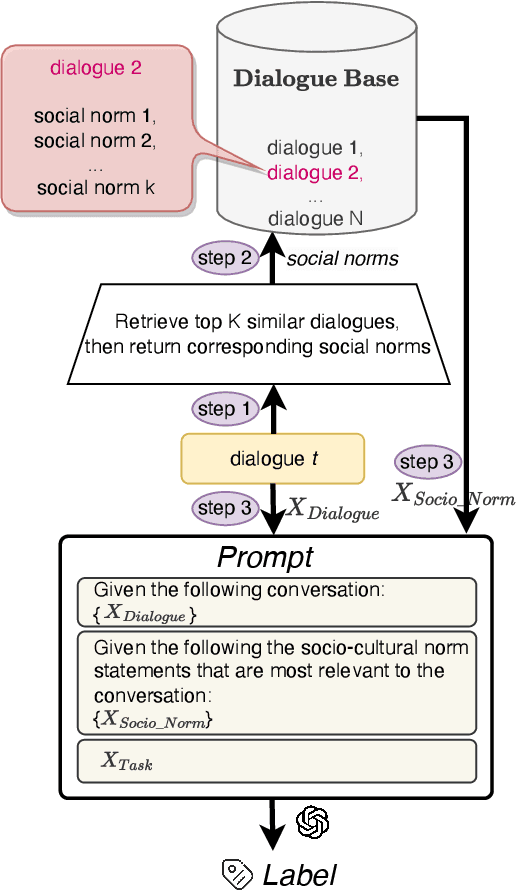
Abstract:Sociocultural norms serve as guiding principles for personal conduct in social interactions, emphasizing respect, cooperation, and appropriate behavior, which is able to benefit tasks including conversational information retrieval, contextual information retrieval and retrieval-enhanced machine learning. We propose a scalable approach for constructing a Sociocultural Norm (SCN) Base using Large Language Models (LLMs) for socially aware dialogues. We construct a comprehensive and publicly accessible Chinese Sociocultural NormBase. Our approach utilizes socially aware dialogues, enriched with contextual frames, as the primary data source to constrain the generating process and reduce the hallucinations. This enables extracting of high-quality and nuanced natural-language norm statements, leveraging the pragmatic implications of utterances with respect to the situation. As real dialogue annotated with gold frames are not readily available, we propose using synthetic data. Our empirical results show: (i) the quality of the SCNs derived from synthetic data is comparable to that from real dialogues annotated with gold frames, and (ii) the quality of the SCNs extracted from real data, annotated with either silver (predicted) or gold frames, surpasses that without the frame annotations. We further show the effectiveness of the extracted SCNs in a RAG-based (Retrieval-Augmented Generation) model to reason about multiple downstream dialogue tasks.
* 17 pages
From Pre-training Corpora to Large Language Models: What Factors Influence LLM Performance in Causal Discovery Tasks?
Jul 29, 2024
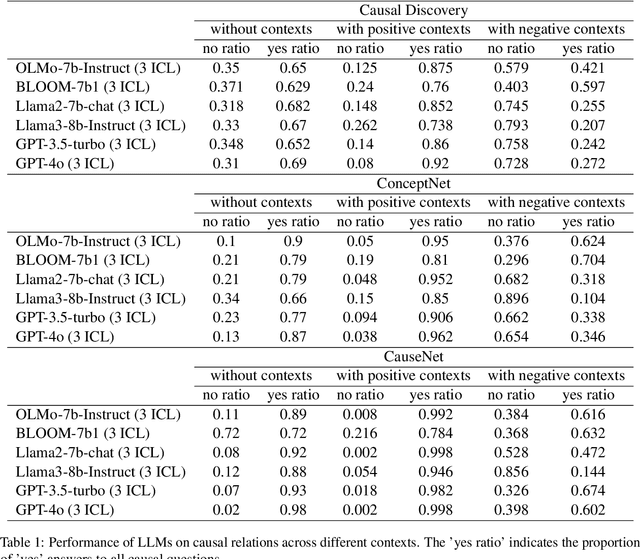
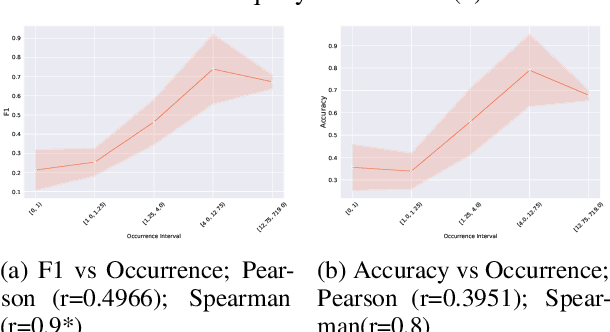
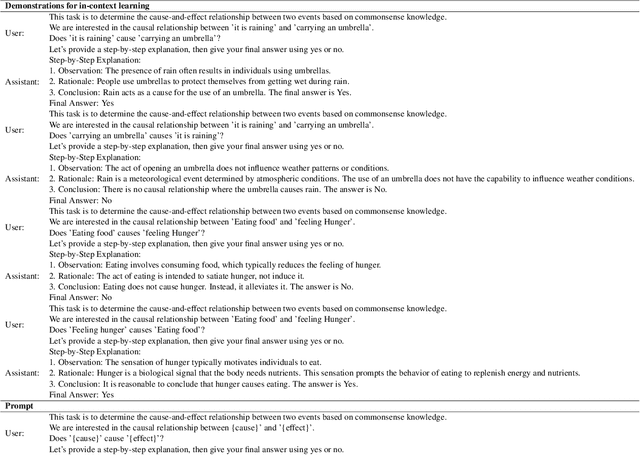
Abstract:Recent advances in artificial intelligence have seen Large Language Models (LLMs) demonstrate notable proficiency in causal discovery tasks. This study explores the factors influencing the performance of LLMs in causal discovery tasks. Utilizing open-source LLMs, we examine how the frequency of causal relations within their pre-training corpora affects their ability to accurately respond to causal discovery queries. Our findings reveal that a higher frequency of causal mentions correlates with better model performance, suggesting that extensive exposure to causal information during training enhances the models' causal discovery capabilities. Additionally, we investigate the impact of context on the validity of causal relations. Our results indicate that LLMs might exhibit divergent predictions for identical causal relations when presented in different contexts. This paper provides the first comprehensive analysis of how different factors contribute to LLM performance in causal discovery tasks.
Bridging Law and Data: Augmenting Reasoning via a Semi-Structured Dataset with IRAC methodology
Jun 19, 2024Abstract:The effectiveness of Large Language Models (LLMs) in legal reasoning is often limited due to the unique legal terminologies and the necessity for highly specialized knowledge. These limitations highlight the need for high-quality data tailored for complex legal reasoning tasks. This paper introduces LEGALSEMI, a benchmark specifically curated for legal scenario analysis. LEGALSEMI comprises 54 legal scenarios, each rigorously annotated by legal experts, based on the comprehensive IRAC (Issue, Rule, Application, Conclusion) framework. In addition, LEGALSEMI is accompanied by a structured knowledge graph (SKG). A series of experiments were conducted to assess the usefulness of LEGALSEMI for IRAC analysis. The experimental results demonstrate the effectiveness of incorporating the SKG for issue identification, rule retrieval, application and conclusion generation using four different LLMs. LEGALSEMI will be publicly available upon acceptance of this paper.
SCAR: Efficient Instruction-Tuning for Large Language Models via Style Consistency-Aware Response Ranking
Jun 16, 2024



Abstract:Recent studies have shown that maintaining a consistent response style by human experts and enhancing data quality in training sets can significantly improve the performance of fine-tuned Large Language Models (LLMs) while reducing the number of training examples needed. However, the precise definition of style and the relationship between style, data quality, and LLM performance remains unclear. This research decomposes response style into presentation and composition styles and finds that, among training data of similar quality, those with higher style consistency lead to better LLM performance. Inspired by this, we introduce Style Consistency-Aware Response Ranking (SCAR), which automatically prioritizes instruction-response pairs in the training set based on their response stylistic consistency. By selecting the most style-consistent examples, ranging from the top 25% to 0.7% of the full dataset, the fine-tuned LLMs can match or even surpass the performance of models trained on the entire dataset in coding and open-ended question-answering benchmarks. Code and data are available at https://github.com/zhuang-li/SCAR .
NAP^2: A Benchmark for Naturalness and Privacy-Preserving Text Rewriting by Learning from Human
Jun 06, 2024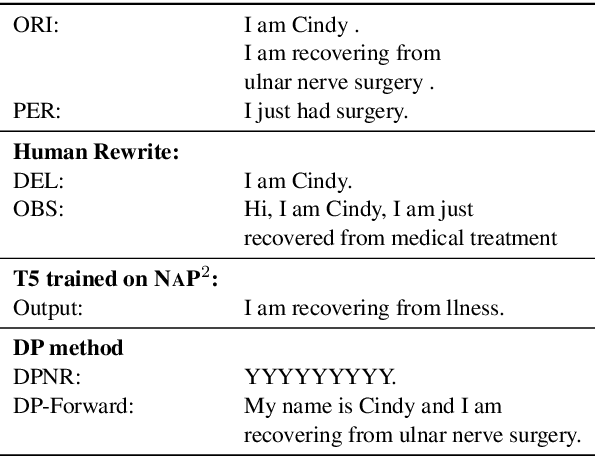
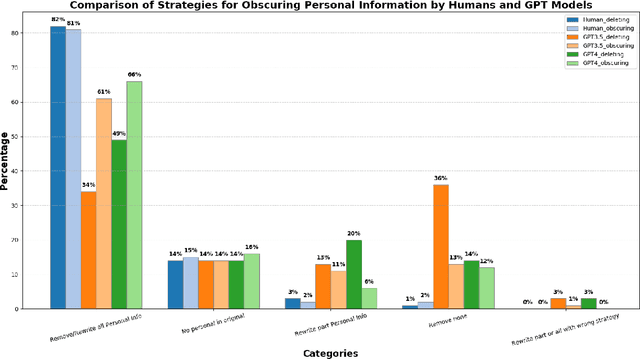
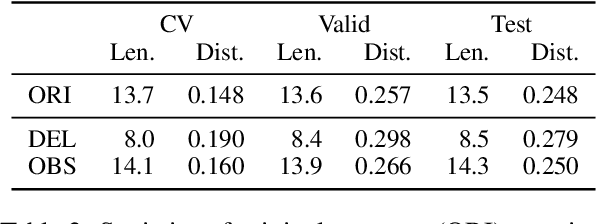
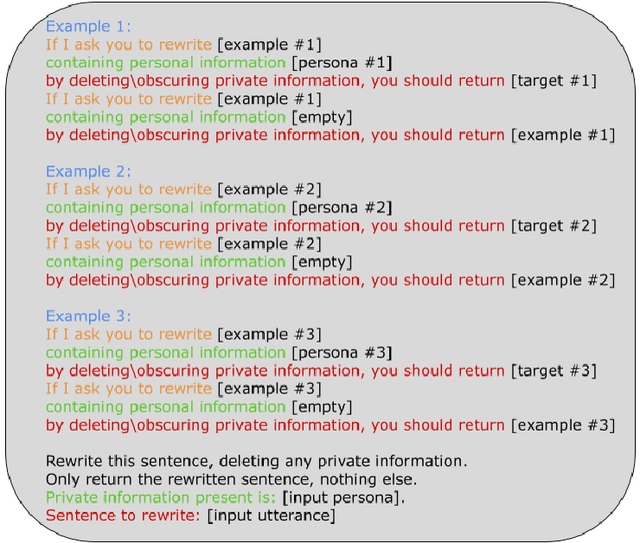
Abstract:Increasing concerns about privacy leakage issues in academia and industry arise when employing NLP models from third-party providers to process sensitive texts. To protect privacy before sending sensitive data to those models, we suggest sanitizing sensitive text using two common strategies used by humans: i) deleting sensitive expressions, and ii) obscuring sensitive details by abstracting them. To explore the issues and develop a tool for text rewriting, we curate the first corpus, coined NAP^2, through both crowdsourcing and the use of large language models (LLMs). Compared to the prior works based on differential privacy, which lead to a sharp drop in information utility and unnatural texts, the human-inspired approaches result in more natural rewrites and offer an improved balance between privacy protection and data utility, as demonstrated by our extensive experiments.
IMO: Greedy Layer-Wise Sparse Representation Learning for Out-of-Distribution Text Classification with Pre-trained Models
Apr 21, 2024Abstract:Machine learning models have made incredible progress, but they still struggle when applied to examples from unseen domains. This study focuses on a specific problem of domain generalization, where a model is trained on one source domain and tested on multiple target domains that are unseen during training. We propose IMO: Invariant features Masks for Out-of-Distribution text classification, to achieve OOD generalization by learning invariant features. During training, IMO would learn sparse mask layers to remove irrelevant features for prediction, where the remaining features keep invariant. Additionally, IMO has an attention module at the token level to focus on tokens that are useful for prediction. Our comprehensive experiments show that IMO substantially outperforms strong baselines in terms of various evaluation metrics and settings.
 Add to Chrome
Add to Chrome Add to Firefox
Add to Firefox Add to Edge
Add to Edge